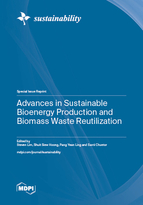Advances in Sustainable Bioenergy Production and Biomass Waste Reutilization
A special issue of Sustainability (ISSN 2071-1050). This special issue belongs to the section "Energy Sustainability".
Deadline for manuscript submissions: closed (31 December 2023) | Viewed by 21831
Special Issue Editors
Interests: catalysis; bioenergy; biomass; kinetics and reactions; supercritical process
Special Issues, Collections and Topics in MDPI journals
Interests: catalysis; bioenergy; biomass; nanoparticles, membrane technology
Interests: environmental catalysis; biomass; wastewater treatment
Interests: biomass pretreatment; biorefinery; bioethanol; bioprocess engineering; process development; techno-economic assessment
Special Issue Information
Dear Colleagues,
Biomass has been an integral part of our civilization since prehistoric times. It has a broad range of applications covering energy, food, specialty chemicals, advanced materials, transportation, constructions and many more, which collectively represent most of our basic needs. Its role as a renewable bioenergy source is becoming increasingly critical lately, due to the impacts of fossil fuels to our environment and ecosystem. Bioenergy derived from biomass can offer several advantages to our current and future energy supply chain, including in being renewable, carbon neutral, widely available irrespective of the geographical location, easily accessible and in readily fitting into the current energy infrastructure. However, there are still technological challenges that need to be overcome with regard to the processing and conversion of biomass to bioenergy to ensure its viability in terms of being both economical and sustainable. Ample research works have attempted to develop numerous advancements in sustainable bioenergy production related to biofuels such as biodiesel, bioethanol, solid biofuel and green aviation fuel. In particular, biomass waste recycling has also been identified as one of the key enablers of sustainable bioenergy production, which ensures the concept of the circular economy is attained in a more holistic manner. Biomass waste recycling and reutilization not only helps to reduce the waste burden to the environment but, at the same time, allows converting the waste into higher value-added bioproducts such as biopolymers, lubricants and specialty chemicals via consolidated biorefinery.
As such, the aim of this Special Issue is to gather and publish the latest advancements in sustainable bioenergy production in various aspects including biomass waste recycling and reutilization. It is hoped that the publications within can fill some of the gaps in our existing knowledge on bioenergy production and biomass waste recycling while simultaneously spurring more in-depth research works in these areas.
The list of relevant topics includes but is not limited to:
- Bioenergy
- Biofuels
- Biomass reutilization
- Process intensification
- Life cycle assessment
- Circular economy
- Biorefinery
- Biomass pretreatment
- Wastewater treatment
- Energy storage
- Energy saving
- Biochar
- Thermochemical conversion
- Process design and optimization
This Special Issue welcomes both technical and review research papers involving fundamental, experimental, applied, numerical and theoretical works which reflect the latest developments and involve state-of-the-art emerging technologies.
Dr. Steven Lim
Dr. Shuit Siew Hoong
Dr. Pang Yean Ling
Dr. Santi Chuetor
Guest Editors
Manuscript Submission Information
Manuscripts should be submitted online at www.mdpi.com by registering and logging in to this website. Once you are registered, click here to go to the submission form. Manuscripts can be submitted until the deadline. All submissions that pass pre-check are peer-reviewed. Accepted papers will be published continuously in the journal (as soon as accepted) and will be listed together on the special issue website. Research articles, review articles as well as short communications are invited. For planned papers, a title and short abstract (about 100 words) can be sent to the Editorial Office for announcement on this website.
Submitted manuscripts should not have been published previously, nor be under consideration for publication elsewhere (except conference proceedings papers). All manuscripts are thoroughly refereed through a single-blind peer-review process. A guide for authors and other relevant information for submission of manuscripts is available on the Instructions for Authors page. Sustainability is an international peer-reviewed open access semimonthly journal published by MDPI.
Please visit the Instructions for Authors page before submitting a manuscript. The Article Processing Charge (APC) for publication in this open access journal is 2400 CHF (Swiss Francs). Submitted papers should be well formatted and use good English. Authors may use MDPI's English editing service prior to publication or during author revisions.
Keywords
- biofuels
- biomass waste
- sustainable production
- waste reutilization
- recycling
- bioenergy
- process intensification
- life cycle assessment
- circular economy
- biorefinery
- biomass pretreatment









